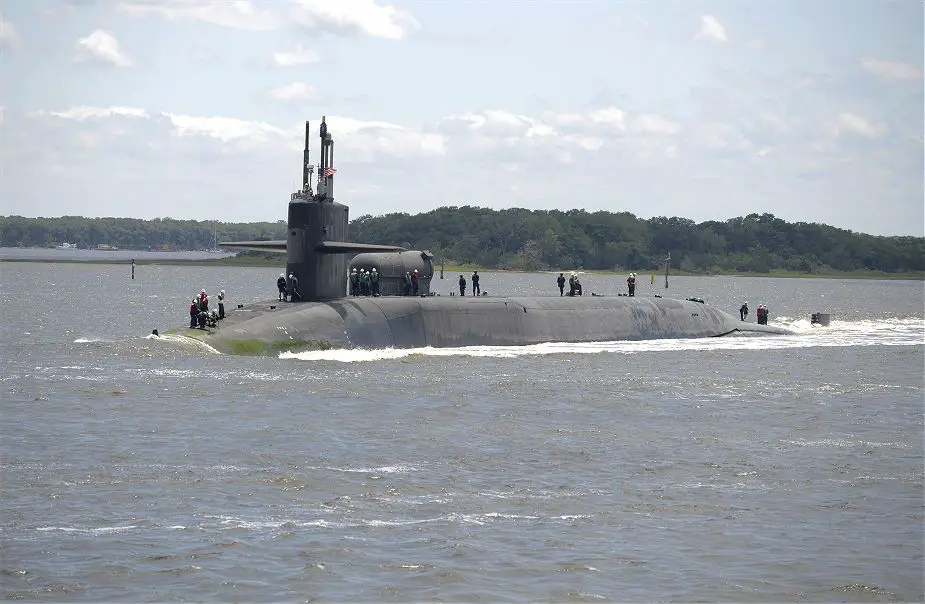Breaking news
During 800 days USS Florida submarine was one of the most versatile and clandestine platforms for US Navy.
During 800 days of deployment, the Ohio-class guided-missile submarine USS Florida (SSGN 78) was one of the most versatile and clandestine platforms in the fleet of U.S. Navy. Guided-missile submarines are capable of carrying up to 154 Tomahawk land-attack cruise missiles and host up to 66 Special Operation Forces.
Follow Navy Recognition on Google News at this link
 The Ohio-class guided-missile submarine USS Florida (SSGN 728) returns to its homeport, Naval Submarine Base Kings Bay, Georgia, May 9, 2020. (Picture source U.S. Navy)
The Ohio-class guided-missile submarine USS Florida (SSGN 728) returns to its homeport, Naval Submarine Base Kings Bay, Georgia, May 9, 2020. (Picture source U.S. Navy)
The USS Florida (SSGN-728) Ohio-class cruise missile submarine, is the sixth ship of the United States Navy to be named for the 27th state. She was commissioned with the hull designation of SSBN-728 in June 1983. The USS Florida entered Norfolk Naval Shipyard in July 2003 to undergo a refueling and conversion from an SSBN (Ballistic Missile Submarine) to an SSGN (Cruise Missile Submarine).
Florida is one of just four guided-missile submarines in the U.S. Navy's fleet and comprises half of the guided-missile submarine force in Kings Bay, home to all East Coast Ohio-class submarines to include five ballistic-missile and two guided-missile submarines. It has completed more than 50 patrols before its conversion to a guided-missile submarine. SSGNs are equipped with superior communications capabilities and have the ability to carry up to 154 Tomahawk land-attack cruise missiles. The platform can also be configured to host up to 66 Special Operation Forces.
While forward deployed, the ship sailed more than 98,000 nautical miles, which is the equivalent to nearly four times around the world, and pinned 202 new submariners with their submarine warfare, or “Dolphins.”
As an Ohio-class submarine, Florida has two crews; blue and gold. These crews of roughly 160 Sailors alternate manning the submarine and typically deploy with the ship for three months before swapping. The blue crew brought the submarine back to its homeport. The crew that isn’t deployed, trains at Trident Training Facility Kings Bay, conducting a rigorous training program including simulated missions and scenarios they could encounter while at sea. This constant training regimen helps ensure the crew is always tactically and operationally ready.
On 19 March 2011, in conjunction with other U.S. Navy and Royal Navy warships and submarines, Florida fired scores of Tomahawk missiles at Libyan air defense targets as part of Operation Odyssey Dawn. Operation Odyssey Dawn was the U.S. code name for the American role in the international military operation in Libya to enforce United Nations Security Council Resolution 1973 during the initial period of 19–31 March 2011 The Tomahawk missile strikes allowed British, French, and allied warplanes to begin enforcing a no-fly zone over Libya, preventing Muammar Gaddafi from using his air force to attack rebels in his country. This was the first combat action for the Florida or any other Ohio-class submarine. During Operation Odyssey Dawn, Florida launched 93 Tomahawk missiles, with 90 effective, out of her total magazine of about 160 missiles.
The Tomahawk is a long-range Land Attack Missile (TLAM), all-weather, jet-powered, subsonic cruise missile that is primarily used by the United States Navy and Royal Navy in ships and submarine-based land-attack operations. At least six variants and multiple upgraded versions have been introduced since then, including air-, sub-, and ground-launched variants and conventional and nuclear-armed ones. As of 2019, only non-nuclear, sea-launched variants assembled by Raytheon are currently in service. It has an operational range of 2,500 km.




























